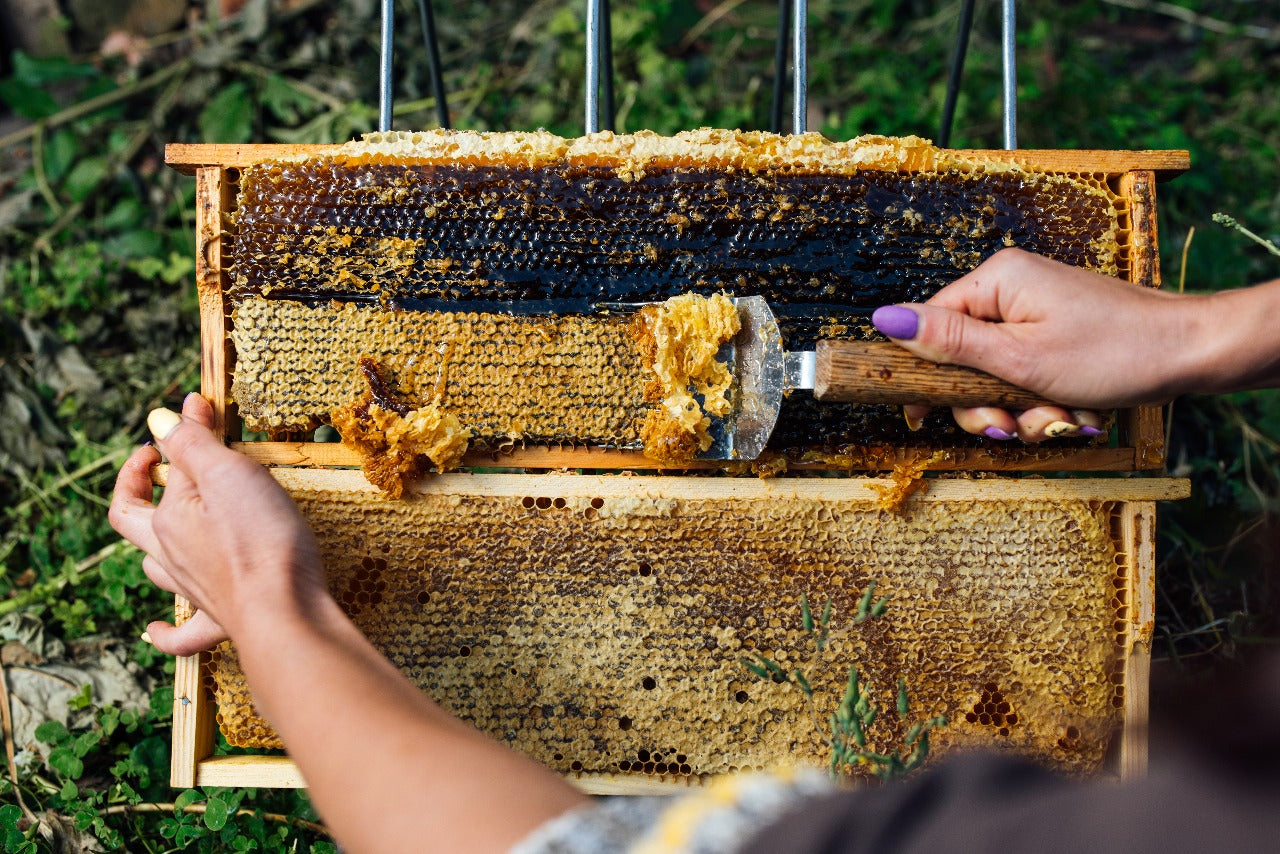Des cosmétiques à l'alimentation, la production de miel est essentielle à de nombreuses activités. Les apiculteurs utilisent divers instruments et procédés pour maintenir la santé et la productivité de leurs ruches et maximiser la production de miel.
Les brosses apicoles jouent un rôle important dans ces articles. Ce blog examine l'importance de la production de miel et comment l'utilisation de brosses apicoles peut améliorer les techniques apicoles.
Les apiculteurs peuvent maximiser leur production de miel tout en assurant la sécurité et le bien-être de leurs abeilles en utilisant des méthodes et un équipement adaptés. Apprenez-en plus sur le rôle crucial des brosses apicoles pour optimiser l'art et la production apicoles.
Comprendre les brosses apicoles
Les apiculteurs utilisent des brosses apicoles comme instruments essentiels pour manipuler correctement les abeilles et accroître la productivité de la ruche. Ces brosses ont été conçues pour transporter les abeilles efficacement et en toute sécurité, sans les blesser ni les gêner.
Il existe différentes variétés de brosses apicoles, chacune ayant une utilité particulière. Lors des inspections de la ruche, les abeilles brossent fréquemment et délicatement les cadres ou les surfaces à l'aide de brosses à poils souples. Elles réduisent les perturbations de la colonie tout en contribuant à maintenir un environnement paisible et contrôlé.
La brosse à plumes est un outil apicole original, très utile pour manipuler les reines. Ses plumes délicates permettent aux apiculteurs de guider et de manipuler la reine en douceur, sans la blesser.
L'utilisation de brosses apicoles ne se limite pas à la simple manipulation. Elles contribuent également à maintenir la ruche propre et hygiénique. Les apiculteurs maintiennent la ruche propre et saine en éliminant soigneusement l'excès de propolis, de cire et autres débris.
L'utilisation de brosses apicoles pour la production de miel présente de nombreux avantages. Elles contribuent à réduire l'hostilité des abeilles en massant délicatement la ruche pour favoriser l'harmonie et la coopération. De plus, le retrait délicat des abeilles des cadres ou autres surfaces permet aux apiculteurs d'extraire le miel ou d'effectuer des inspections avec un minimum de perturbations. Cela contribue à maintenir la santé et la productivité de la ruche, tout en garantissant la sécurité de l'apiculteur.
Utiliser des brosses pour manipuler les abeilles en toute sécurité
Les apiculteurs et la santé des colonies d'abeilles doivent appliquer des procédures de manipulation saines et appropriées. L'utilisation de brosses apicoles est essentielle pour assurer une gestion sûre des abeilles et effectuer des inspections des ruches avec le moins de perturbations possible.
Les brosses apicoles offrent aux apiculteurs un instrument doux et efficace pour déplacer les abeilles sans les blesser ni les perturber, contribuant ainsi à une gestion apicole en toute sécurité. Il est crucial de garder son sang-froid et d'éviter tout mouvement inattendu à l'approche des ruches, car cela pourrait les mettre sur la défensive. Les apiculteurs peuvent éloigner délicatement et méthodiquement les abeilles des cadres, des éléments de la ruche ou d'autres surfaces grâce aux brosses, ce qui réduit les risques de piqûres et préserve un environnement contrôlé à l'intérieur de la ruche.
Il est essentiel de respecter quelques recommandations et principes lors de la manipulation des abeilles avec des brosses. Choisissez d'abord une brosse à poils doux pour protéger les abeilles. Brossez délicatement les abeilles par mouvements doux, en les encourageant à bouger sans les déranger. Veillez à ne pas irriter les abeilles en appuyant trop fort ou en donnant des coups de brosse trop brusques, ce qui pourrait provoquer des piqûres.
Lors de l'inspection des ruches, concentrez-vous sur des abeilles individuelles ou de petits groupes plutôt que de tenter de déplacer simultanément de grands groupes d'abeilles à l'aide d'une brosse. Cela rend la manipulation plus précise et plus maîtrisée. De plus, soyez attentif à la présence de la reine et soyez prudent lorsque vous utilisez des brosses à proximité.
De plus, il est essentiel de se rappeler que les brosses apicoles doivent être propres et exemptes de produits chimiques ou de toxines susceptibles de mettre en danger les abeilles ou de polluer la ruche. Pour les maintenir en parfait état et manipuler les abeilles en toute sécurité, nettoyez-les fréquemment.
Les apiculteurs peuvent réduire considérablement leur risque de se faire piquer, maintenir un environnement de ruche paisible et améliorer la sécurité générale et le bien-être de la colonie en adhérant à ces recommandations et en utilisant correctement les brosses d'apiculture.
Comment choisir la bonne brosse d'apiculture pour votre ruche
De nombreux facteurs doivent être pris en compte lors du choix d'une brosse apicole afin de garantir qu'elle réponde aux exigences spécifiques de votre ruche et de vos techniques apicoles. Tenez compte des facteurs importants suivants pour choisir la brosse la plus adaptée :
Considérations pour le choix d'une brosse d'apiculture :
Type de poils : Le crin de cheval ou les fibres synthétiques sont fréquemment utilisés pour fabriquer les poils des brosses apicoles. Si les brosses synthétiques sont plus durables et faciles à nettoyer, les brosses en crin de cheval sont respectueuses des abeilles et sont très appréciées des apiculteurs.
Taille du pinceau : Tenez compte des dimensions de la brosse et de sa compatibilité avec votre ruche et vos cadres. Une brosse trop grande pourrait être difficile à manipuler, et une brosse trop petite pourrait gêner le déplacement des abeilles.
Les différentes possibilités de brosses proposées et leur adaptation aux conditions particulières de la ruche :
Brosses à poils doux : Ces brosses sont idéales pour manipuler les abeilles en douceur et réduire les risques de les mettre en danger ou de les déranger. Elles sont efficaces pour les inspections courantes des ruches et la plupart des conditions de vie.
Brosses à long manche : Les apiculteurs peuvent accéder aux abeilles dans les sections de la ruche difficiles d'accès ou lorsqu'ils travaillent avec des hausses profondes, grâce à des brosses à manches plus longs qui offrent plus de portée et de flexibilité.
Brosses en forme de J : Avec leurs poils disposés en J, ces brosses ont une forme distinctive. Elles sont particulièrement adaptées aux tâches délicates comme l'introduction des reines ou le retrait des essaims, car elles balayent les abeilles en douceur, sans les écraser ni les blesser.
Suggestions pour sélectionner la meilleure brosse apicole en fonction des besoins de votre ruche :
Lors du choix d'une brosse apicole, tenez compte des besoins spécifiques de votre ruche et de vos techniques apicoles. Tenez compte de facteurs tels que la taille et la conception de votre ruche, la disposition de vos abeilles et vos tâches habituelles. Pour vous faire une idée en fonction de votre région et de ses conditions, il peut être utile de demander conseil à des apiculteurs expérimentés ou de contacter une association apicole locale.
La brosse d'apiculture appropriée peut vous aider à entretenir votre ruche en douceur et efficacement, à protéger le bien-être de vos abeilles et à augmenter la productivité lors des inspections de la ruche et de la production de miel.
Techniques et bonnes pratiques
Utiliser les bonnes méthodes et suivre les meilleures pratiques pour optimiser les brosses apicoles et améliorer la production de miel est essentiel. Voici quelques points essentiels à retenir :
Techniques appropriées pour utiliser efficacement les brosses apicoles :
Avec une brosse apicole, brossez doucement et délicatement les abeilles pour les éloigner des zones désirées. Évitez d'utiliser une force excessive ou un frottement abrasif, car cela peut effrayer les abeilles et les mettre sur la défensive.
Concentrez-vous sur le brossage des abeilles individuelles plutôt que sur de grands groupes.Cela réduit la possibilité de blesser involontairement les abeilles ou de produire des perturbations inutiles à l’intérieur de la ruche.
Maintenir l'hygiène et la propreté des pinceaux :
Nettoyage régulier : Pour éviter la transmission de polluants ou de maladies entre les ruches, nettoyez les brosses d'apiculture après chaque utilisation. Nettoyez-les à l'eau tiède et au savon doux pour éliminer les saletés et les résidus.
Brosses dédiées:Pour éviter toute contamination croisée et préserver l'hygiène spécifique à la ruche, pensez à utiliser des brosses distinctes pour certaines ruches ou tâches.
Meilleures pratiques pour intégrer les brosses apicoles dans votre production de miel et votre routine apicole :
Utilisez des brosses d'apiculture pour éloigner délicatement les abeilles lors des inspections de routine des ruches afin de pouvoir accéder aux cadres ou effectuer des opérations importantes sans déranger les abeilles.
Les brosses apicoles sont très utiles pour manipuler les reines lors de leur inspection ou de leur transfert, selon les spécialistes de la gestion des reines. Pour préserver la sécurité et le bien-être de la reine, utilisez-les avec précaution et précision.
Grâce à des formations ou aux conseils d'apiculteurs expérimentés, familiarisez-vous avec les bonnes pratiques apicoles, notamment l'utilisation efficace des brosses. Cela favorise une gestion efficace des abeilles et renforce votre confiance en vous.
En adhérant à ces méthodes et meilleures pratiques, les apiculteurs utilisent des brosses apicoles dans leur production de miel et leur routine apicole en phéromonant la santé des abeilles, en réduisant l'agitation à l'intérieur de la ruche et en aidant les apiculteurs à avoir des opérations réussies et fructueuses.
Conseils de nettoyage et d'entretien pour votre brosse d'apiculture
L'efficacité de votre brosse apicole et la prévention de la transmission de polluants ou de maladies entre vos ruches dépendent d'un nettoyage et d'un entretien réguliers. Un nettoyage et un entretien réguliers sont essentiels pour maintenir votre brosse apicole en parfait état.
Nettoyage régulier : Pour éliminer toute saleté, débris ou propolis qui aurait pu se déposer sur la brosse après chaque utilisation, nettoyez-la soigneusement. Frottez-la délicatement avec de l'eau tiède et du savon ou du détergent. Avant de la ranger, rincez-la abondamment et assurez-vous qu'elle est bien sèche.
Désinfection: Désinfectez régulièrement la brosse pour éliminer tout agent pathogène potentiel. Laissez-la tremper quelques minutes dans une solution d'eau et d'eau de Javel (un volume d'eau de Javel pour dix volumes d'eau). Rincez ensuite soigneusement la brosse à l'eau claire.
Inspection: Inspectez régulièrement les poils de votre brosse d'apiculture pour détecter tout signe de dommage ou d'usure. Pour préserver l'efficacité de la brosse, coupez les poils lâches ou effilochés.
Stockage: Pour éviter l'accumulation d'humidité et le développement de moisissures, rangez vos brosses d'apiculture dans un endroit propre et sec. Conservez-les dans un étui ou un récipient pour les protéger de la saleté et des autres impuretés.
Brosses dédiéesUtiliser des brosses spécifiques pour chaque ruche ou tâche afin d'éviter toute contamination croisée. Cela préserve la santé et la propreté de chaque ruche.
Remplacement: Les poils de votre brosse d'apiculture peuvent s'user ou s'abîmer avec le temps. Lorsqu'ils commencent à ramollir ou à cesser de fonctionner, remplacez-la.
Vous pouvez maintenir votre matériel apicole en bon état et contribuer à la santé et à la productivité de vos abeilles en suivant ces conseils de nettoyage et d'entretien. Une apiculture performante et durable repose sur un nettoyage régulier et un entretien approprié.
Brossage apicole d'OZ Armour
En matière de brosses apicoles, OZ Armour s'impose comme le premier choix des apiculteurs en quête d'une qualité supérieure et d'une gamme complète de produits apicoles. Notre engagement envers l'excellence se reflète dans chaque aspect de nos brosses apicoles.
Fabriquées avec précision et à partir de matériaux haut de gamme, nos brosses sont conçues pour être durables et très efficaces pour manipuler les abeilles. Mais notre offre va bien au-delà. Chez OZ Armour, nous sommes fiers de proposer les meilleurs produits apicoles du secteur. Des combinaisons d'apiculteur aux voiles de protection et autres équipements essentiels, nous avons tout ce qu'il vous faut pour une apiculture réussie et en toute sécurité.
Notre engagement envers un service client exceptionnel vous permet de compter sur nous pour tous vos besoins apicoles. Que vous soyez apiculteur chevronné ou débutant, OZ Armour est votre partenaire de confiance. Nous vous proposons des brosses apicoles de haute qualité et une gamme complète de fournitures apicoles pour soutenir votre passion et garantir une sécurité et une productivité optimales dans vos activités apicoles.
Choisissez OZ Armour pour une qualité, une fiabilité et la commodité inégalées de trouver tous vos essentiels d'apiculture au même endroit.












